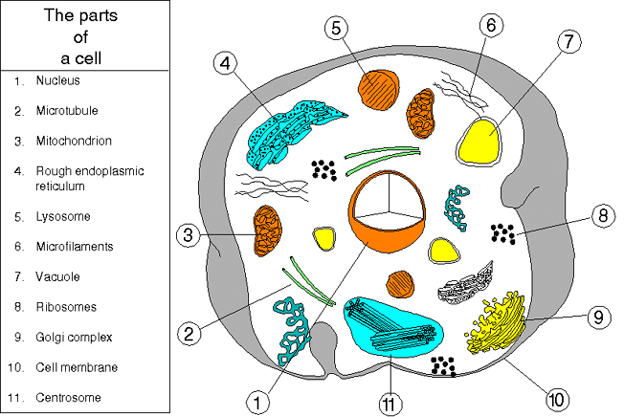Example Of Animal Cell Biography
Source:- Google.com.pk
4.4.1 Outline the use of polymerase chain reaction (PCR) to copy and amplify minute quantities of DNA.
Polymerase chain reaction is used to copy and amplify minute quantities of DNA. It can be useful when only a small amount of DNA is available but a large amount is required to undergo testing. We can use DNA from blood, semen, tissues and so on from crime scenes for example. The PCR requires high temperature and a DNA polymerase enzyme from Thermus aquaticus (a bacterium that lives in hot springs).
4.4.2 State that, in gel electrophoresis, fragments of DNA move in an electric field and are separated according to their size.
In gel electrophoresis, fragments of DNA move in an electrical field and are separated according to their size.
4.4.3 State that gel electrophoresis of DNA is used in DNA profiling.
Gel electrophoresis of DNA is used in DNA profiling.
4.4.4 Describe the application of DNA profiling to determine paternity and also in forensic investigations.
Organisms have short sequences of bases which are repeated many times. These are called satellite DNA. These repeated sequences vary in length from person to person. The DNA is copied using PCRand then cut up into small fragments using restriction enzymes. Gel electrophoresis separates fragmented pieces of DNA according to their size and charge. This gives a pattern of bands on a gel which is unlikely to be the same for two individuals. This is called DNA profiling. DNA profiling can be used to determine paternity and also in forensic investigations to get evidence to be used in a court case for example.
4.4.5 Analyse DNA profiles to draw conclusions about paternity or forensic investigations.
For a suspect look for similarities between the DNA found at the crime scene and the suspect. For a paternity test, look for similarities between the child and the possible father.
4.4.6 Outline three outcomes of the sequencing of the complete human genome.
It is now easier to study how genes influence human development.
It helps identify genetic diseases.
It allows the production of new drugs based on DNA base sequences of genes or the structure of proteins coded for by these genes.
It will give us more information on the origins, evolution and migration of humans.
4.4.7 State that, when genes are transferred between species, the amino acid sequence of polypeptides translated from them is unchanged because the genetic code is universal.
When genes are transferred between species, the amino acid sequence of polypeptides translated from them is unchanged because the genetic code is universal.
4.4.8 Outline a basic technique used for gene transfer involving plasmids, a host cell (bacterium, yeast or other cell), restriction enzymes (endonucleases) and DNA ligase.
The human gene that codes for insulin can be inserted into a plasmid and then this plasmid can be inserted into a host cell such as a bacterium. The bacterium can then synthesis insulin which can be collected and used by diabetics. This is done as follows. The messenger RNA which codes for insulin is extracted from a human pancreatic cell which produces insulin. DNA copies are then made from this messenger RNA by using the enzyme reverse transcriptase and these DNA copies are then given extra guanine nucleotides to the end of the gene to create sticky ends. At the same time, a selected plasmid is cut using restriction enzymes which cut the DNA at specific base sequences. Then extra cytosine nucleotides are added to create sticky ends. Once we have both the plasmid and the gene ready, these are mixed together. The two will link by complementary base pairing (between cytosine and guanine) and then DNA ligase is used to make the sugar phosphate bonds. The plasmids with the human insulin gene (called recombinant plasmids) can then be mixed with host cells such as bacterium. The bacterium will take in the plasmid and start producing insulin which can then be collected and purified.
4.4.9 State two examples of the current uses of genetically modified crops or animals.
The transfer of a gene for factor IX which is a blood clotting factor, from humans to sheep so that this factor is produced in the sheep’s milk.
The transfer of a gene that gives resistance to the herbicide glyphosate from bacterium to crops so that the crop plants can be sprayed with the herbicide and not be affected by it
Example Of Animal Cell Animal Cell Model Diagram Project Parts Structure Labeled Coloring and Plant Cell Organelles Cake


Example Of Animal Cell Animal Cell Model Diagram Project Parts Structure Labeled Coloring and Plant Cell Organelles Cake


Example Of Animal Cell Animal Cell Model Diagram Project Parts Structure Labeled Coloring and Plant Cell Organelles Cake


Example Of Animal Cell Animal Cell Model Diagram Project Parts Structure Labeled Coloring and Plant Cell Organelles Cake


Example Of Animal Cell Animal Cell Model Diagram Project Parts Structure Labeled Coloring and Plant Cell Organelles Cake


Example Of Animal Cell Animal Cell Model Diagram Project Parts Structure Labeled Coloring and Plant Cell Organelles Cake


Example Of Animal Cell Animal Cell Model Diagram Project Parts Structure Labeled Coloring and Plant Cell Organelles Cake


Example Of Animal Cell Animal Cell Model Diagram Project Parts Structure Labeled Coloring and Plant Cell Organelles Cake


Example Of Animal Cell Animal Cell Model Diagram Project Parts Structure Labeled Coloring and Plant Cell Organelles Cake


Example Of Animal Cell Animal Cell Model Diagram Project Parts Structure Labeled Coloring and Plant Cell Organelles Cake


Example Of Animal Cell Animal Cell Model Diagram Project Parts Structure Labeled Coloring and Plant Cell Organelles Cake
No comments:
Post a Comment